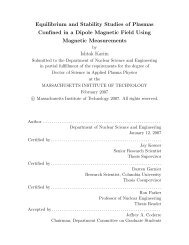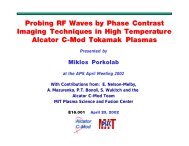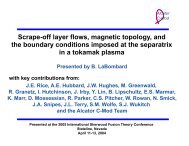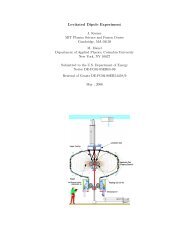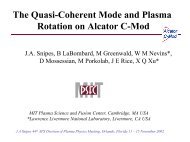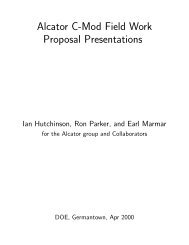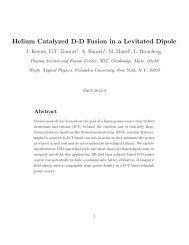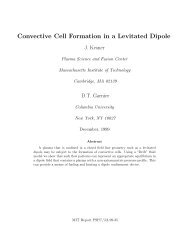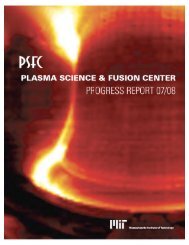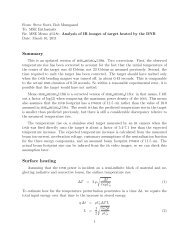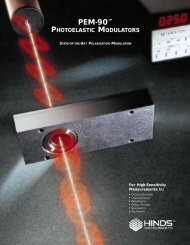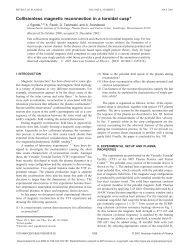Download a copy of the latest PSFC Progress Report - Plasma ...
Download a copy of the latest PSFC Progress Report - Plasma ...
Download a copy of the latest PSFC Progress Report - Plasma ...
You also want an ePaper? Increase the reach of your titles
YUMPU automatically turns print PDFs into web optimized ePapers that Google loves.
ess in developing new hybrid fluid/drift-kinetic<br />
closure models, which are being implemented in<br />
codes that are used to describe nonlinear macroscopic<br />
behavior in tokamaks. The focus to date<br />
has been on <strong>the</strong> electron dynamics, with ion behavior<br />
to be considered next. The hybrid fluid/<br />
drift-kinetic description being developed and<br />
implemented in <strong>the</strong> nonlinear MHD stability code<br />
“NIMROD” will be used to model longer wavelength<br />
features associated with macroscopic behavior<br />
in tokamak plasmas. The motivation here<br />
is to develop a well-grounded <strong>the</strong>oretical model<br />
to analyze slowly growing macroscopic instabilities<br />
in high-temperature, magnetically confined<br />
tokamak plasmas. We were able to derive analytic<br />
dispersion relations, valid over a wide range <strong>of</strong><br />
plasma parameters that could be used to verify<br />
large extended MHD codes, such as NIMROD.<br />
O<strong>the</strong>r work in this area has included improved<br />
analytic solutions to <strong>the</strong> MHD equilibrium equations,<br />
and <strong>the</strong> derivation <strong>of</strong> various stability comparison<br />
<strong>the</strong>orems.<br />
We have also performed extensive investigations<br />
<strong>of</strong> turbulence in tokamaks, where density fluctuation<br />
levels are normally regulated by plasma<br />
flow shear referred to as zonal flow. In trapped<br />
electron mode (TEM) turbulence, an apparent<br />
contradiction had emerged. On <strong>the</strong> one hand,<br />
we had previously discovered that zonal flows<br />
produced a large nonlinear upshift <strong>of</strong> <strong>the</strong> critical<br />
density gradient for <strong>the</strong> onset <strong>of</strong> TEM turbulence.<br />
<strong>PSFC</strong> Associate Director Jeffrey Freidberg with Librarian Jason Thomas.<br />
On <strong>the</strong> o<strong>the</strong>r hand, a separate study <strong>of</strong> TEM turbulence<br />
claimed zonal flows were unimportant.<br />
In collaboration with researchers from <strong>the</strong> SciDAC<br />
Center for <strong>the</strong> Study <strong>of</strong> <strong>Plasma</strong> Microturbulence,<br />
we reconciled <strong>the</strong> two results by showing that<br />
TEM zonal flows vary strongly with <strong>the</strong> ratio <strong>of</strong><br />
density to temperature gradient scale lengths.<br />
This study took <strong>the</strong> important step <strong>of</strong> comparing<br />
gyrokinetic particle and continuum microturbulence<br />
simulations with full electron dynamics. In<br />
complementary work, we continued to improve<br />
gyrokinetic collision operators for use in realistic<br />
plasma microturbulence simulations. Collisions<br />
play an important role in plasma turbulence near<br />
<strong>the</strong> threshold for excitation <strong>of</strong> <strong>the</strong> modes, where<br />
most experiments operate.<br />
Existing nonlinear gyrokinetic and extended MHD<br />
codes are unable to predict <strong>the</strong> evolution <strong>of</strong> tokamak<br />
plasma on transport time scales since that<br />
requires a simultaneous knowledge <strong>of</strong> <strong>the</strong> global<br />
axisymmetric radial electric field and its associated<br />
flow. To predict long-time-scale plasma evolution<br />
along with <strong>the</strong> superimposed zonal flow<br />
established on shorter time scales and at shorter<br />
radial scale lengths, hybrid fluid/gyrokinetic descriptions<br />
are required. The <strong>the</strong>ory group developed<br />
<strong>the</strong> first such description (valid for arbitrary<br />
collisionality) by using conservation and o<strong>the</strong>r<br />
moment equations along with solutions to <strong>the</strong><br />
gyrokinetic equation. This hybrid description is<br />
presently being implemented in <strong>the</strong> GS2/Trinity<br />
codes. In a separate study, an analytical evaluation<br />
<strong>of</strong> <strong>the</strong> residual zonal flow level was performed in<br />
<strong>the</strong> high-confinement pedestal region just inside<br />
<strong>the</strong> separatrix. Beyond <strong>the</strong> separatrix <strong>the</strong> magnetic<br />
field lines connect to <strong>the</strong> vacuum chamber<br />
wall. Inside <strong>the</strong> pedestal <strong>the</strong> plasma gradients are<br />
strong, and <strong>the</strong> resulting strong radial electric<br />
field and its shear were shown to modify zonal<br />
flow behavior. In addition, <strong>the</strong> effect <strong>of</strong> this strong<br />
electric field and its shear on ion and impurity<br />
flow, ion heat transport, and parallel current was<br />
evaluated. These results explained pedestal flow<br />
measurements on Alcator C-Mod.<br />
In a new program that complements our extensive<br />
tokamak research program, <strong>the</strong> <strong>the</strong>ory group<br />
has begun an effort focused on equilibrium and<br />
transport in stellarators. Unlike tokamaks, stellarators<br />
are inherently steady state, but with magnetic<br />
16 <strong>PSFC</strong> <strong>Progress</strong> <strong>Report</strong> 09–11



